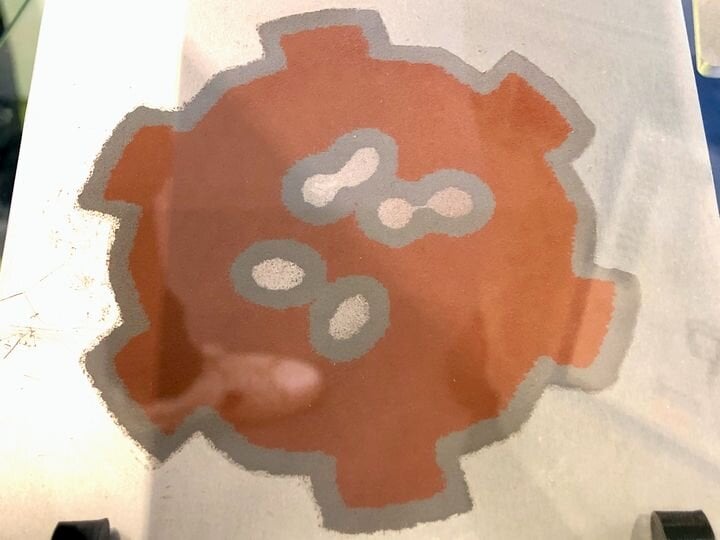![Aerosint has developed a very intriguing powder 3D printer component [Source: Fabbaloo]](https://fabbaloo.com/wp-content/uploads/2020/05/image-asset_img_5eb08be8690e4.jpg)
Aerosint has the most amazing capability: to enable multi-material powder 3D printing.
Powder 3D printing processes like SLS and DLMS are among the most desirable in the world of 3D printing, as they have two important attributes: the prints can be of very high resolution, and the complete avoidance of support material.
Powder 3D Printing Benefits
The high resolution is due to the pinpoint melt pool of a focused laser that selectively sinters the flat bed of powder, while the fragile and unattached model segments are automatically supported by surrounding powder.
The supporting powder effect leads to another spectacular capability: the ability to 3D print “full” build chambers, jammed with parts in three dimensions. No other 3D printing process can boast of the same ability, and this allows production machines to run continuously to batch together large quantities of 3D printed parts.
With all those benefits, you’d think everyone would be using powder-based 3D printing systems.
There are some drawbacks to powder technologies, but the major one in my mind is that the powder used in a 3D print job must be uniformly the same material. You can 3D print a nylon object, but you can’t 3D print a nylon AND flexible object.
Aerosint Selective Powder Deposition
![Aerosint 3D printer powder recoater in action [Source: Aerosint]](https://fabbaloo.com/wp-content/uploads/2020/05/image-asset_img_5eb08be89b615.jpg)
Until now. Aerosint has developed a unique technology that will be of great interest to any powder-based 3D printer manufacturer.
They have created a specialized recoater, the component that lays down the flat bed of powder, that can selectively deposit different powders on the same layer.
Aerosint does not manufacture their own 3D printer, but intends on partnering with other 3D printer manufacturers to incorporate their unusual recoating technology.
How does it work? Here is an overview of their process, which involves the use of multiple “patterning drums”, each distributing a different powder material on the same surface.
![The Aerosint selective powder distribution process overview [Source: Aerosint]](https://fabbaloo.com/wp-content/uploads/2020/05/image-asset_img_5eb08be8dc222.jpg)
You can see how it works in their short video:
Aerosint Powder Combinations
![A copper-alloy / stainless steel powder combination by Aerosint [Source: Fabbaloo]](https://fabbaloo.com/wp-content/uploads/2020/05/image-asset_img_5eb08be935c34.jpg)
In the video you can see a number of startling combinations of powders, both thermoplastics and metal powders. Of particular interest is the metal combinations, where materials such as copper and steel could be combined to form objects with unusual electrical properties.
![A multicolor TPU 3D printing powder combination by Aerosint [Source: Fabbaloo]](https://fabbaloo.com/wp-content/uploads/2020/05/image-asset_img_5eb08be98b274.jpg)
Similarly, they have an example of a gradient pattern, where one material “blends” into another. The example in the video shows two differently colored powders, suggesting a wide variety of possible applications. The Aerosint technology can mix colors as well as materials.
Having looked at some examples of their selective powder depositions, one question I do have is the potential resolution of the system. The examples seem a bit coarse, with far less resolution than the laser-based systems intended to sinter them.
Aerosint Partnerships
So far, it seems that Aerosint has secured one partnership with a 3D printer manufacturer, that being Germany-based Aconity 3D. That company provides powder-based systems for 3D printing metal objects. In one of their systems it is now possible to select the Aerosint recoater as a build option when purchasing equipment.
Aerosint informs us they are currently working with other 3D printer manufacturers and hope to make further partnership announcements.
The Aerosint recoater is capable of being used with metal, ceramic or polymer powders, making it a very flexible option, and offering them the widest possible set of potential partners among 3D printer manufacturers.
Aerosint Application Challenges
I am wondering whether Aerosint might face a bit of a challenge: their technology is so unique and so different from current abilities that they may find low demand for the product. It could be a bit of a chicken and egg scenario, where they need to promote the possibilities of unique applications to trigger the imagination of potential customers.
Via Aerosint

